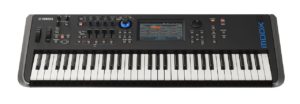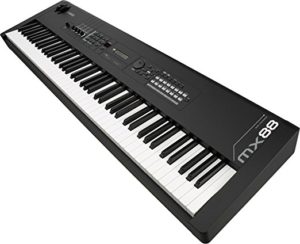I’m pretty well convinced that the Yamaha MODX leak is legitimate.
BTW, I think Yamaha will pronounce the name “MO D X” to reflect a continuation of the MO heritage and to emphasize the FM-X technology by recalling the DX synth line.
Here’s a quick table comparing MODX versus Montage. There are still a few blanks in the table which need to be filled out.
| Feature | MODX | Montage |
|---|---|---|
| Display | 7″ WVGA color TFT | 7″ WVGA color TFT |
| AWM2 poly | 128 | 128 |
| FM-X poly | 64 | 128 |
| SSS | 4 parts | 8 parts |
| Faders | 4 | 8 |
| Encoders | 4 | 8 |
| Buttons | 4 | 8 |
| Ribbon | No | Yes |
| USB audio in | 4 channels (2 stereo) | 6 channels (3 stereo) |
| USB audio out | 10 channels (5 stereo) | 16 channels |
| Sampling frequency | 44.1kHz | Up to 192kHz |
| ADC inputs | 2 | 2 |
| Dual insert effects | 12 parts+A/D | 16 parts+A/D |
| Waveforms | 6,347 | 6,347 |
| Waveform ROM | 5.67GB | 5.67GB |
| Flash ROM | 1.00GB | 1.75GB |
| User Performances | 640 | 640 |
| Library Performances | 5,120 | 5,120 |
| Scenes | 8 per Perf | |
| Arpeggios | 10,239 | 10,000+ |
| Simult Arp | 8 | |
| MIDI | IN,OUT | IN,OUT,THRU |
| Output | Unbalanced | Balanced |
| Keyboard | Synth | FSX |
| Aftertouch | No | Yes |
| Weight 61-key | 14.6 pounds | 33.1 pounds |
Of course, the important question is, “How much of the Montage did Yamaha leave out?”
First, let me say, you do get a lot. The MODX has full fat waveforms, arpeggios and performances (including voices in the flat Yamaha user interface world). Having heard and played the Full Monty, I will definitely be looking at the MODX to replace my MOX6, especially if the MODX6 weighs in at roughly the same weight.
There have always been differences between the top-of-the-line (TOTL) synth and its mid-range brother. The Montage has a metal chassis, balanced outputs, internal power supply (AKA “AC power”) and an FSX keybed with aftertouch. Therefore, I expected a plastic chassis, unbalanced outputs, external power supply and a synth action (61-key model) without aftertouch. Given the history of the MO product line, one could also expect fewer sliders, knobs and buttons. I’m glad to see the return of sliders, by the way. The plastic case of the MOX6 has held up rather well and usually guitars walk away worse for wear when they collide with the MOX6!
At this price point, I wouldn’t expect Pure Analog Circuit (PAC) audio either. I’m still a little surprised that the Genos offers TOSlink in place of PAC, BTW.
Thankfully, Yamaha did not skimp on the display. It’s the same 7″ wide VGA color TFT. I suspect that the Montage and MOXD share the same software code base, which was not true of the Motif XS/XF and the MOX/MOXF. The MODX has the same number of user and library performances. All of this parity is great news for the end user.
The MODX audio spec is cut down from the Montage. I expected this, too, knowing about the internal architecture of the Montage. The Montage has a dedicated SSP2 integrated circuit (IC) for audio routing and USB interface. This is like having a Steinberg UR44+ in the guts of your studio synthesizer. Thus, the MODX (probably without the SSP2) has fewer USB audio input and output channels. Although the leak doesn’t reveal the sampling rate, I doubt if the MODX will do 192kHz. [I wouldn’t mind being wrong about this doubt.]
The leaked write-up suggests that the MODX has the same effect algorithms as the Montage. The number of dual insert effects is lower in the MODX: 12 parts plus A/D input versus the Montage’s 16 parts plus A/D input.
I suspect that the number of parts per performance has been reduced from sixteen to eight. The front panel buttons provide access to eight elements (as expected with AWM2) or eight parts. Seamless Sound Switching (SSS) is supported for performances with up to 4 parts (versus 8 Montage parts). Take this speculation with a grain of salt as it’s trying to read between the lines of the write-up.
It is true, however, that the four sliders, encoder knobs and buttons are shared across eight parts or elements. Each control type has a button to select between group 1 to 4 and group 5 to 8.
- With four sliders, don’t expect to go all “Hammond” with drawbars.
- With four immediately accessible scenes (i.e., without making two button presses under live fire), don’t expect to jump across more than four voices on the fly.
The second concern is a serious one because Yamaha ditched a whole raft of buttons from the right hand side of the front panel (cost saving!) I currently rely on the MOX buttons to select among sixteen voices on the fly. This is important to me because I’m holding down bass and melody lines with our trio. I must make fast patch changes or something gets dropped musically.
The only place where I feel like Yamaha gratuitously tiered the Montage over the MODX is expansion flash memory. The expansion flash memory is the left over flash ROM capacity beyond the factory sound set. Trust me, Yamaha is not saving money by cutting this spec — it is a marketing decision.
There is so much yet to learn about the MODX. I’m hoping that Yamaha retained the deep performance (voice) editing from the Montage. The leaked write-up does not mention a “performance recorder,” so this is a total blank spot, too. Pricing for all models is yet known. Yamaha may sell the MODX at a premium versus the MOXF until the old MOXF stock is sold.
At this stage, I’m quite pleased. My MOX is going strong and makes it to the gig every Sunday. However, I have tasted the future with Genos™ and look forward to trying the Yamaha MODX.
Copyright © 2018 Paul J. Drongowski




